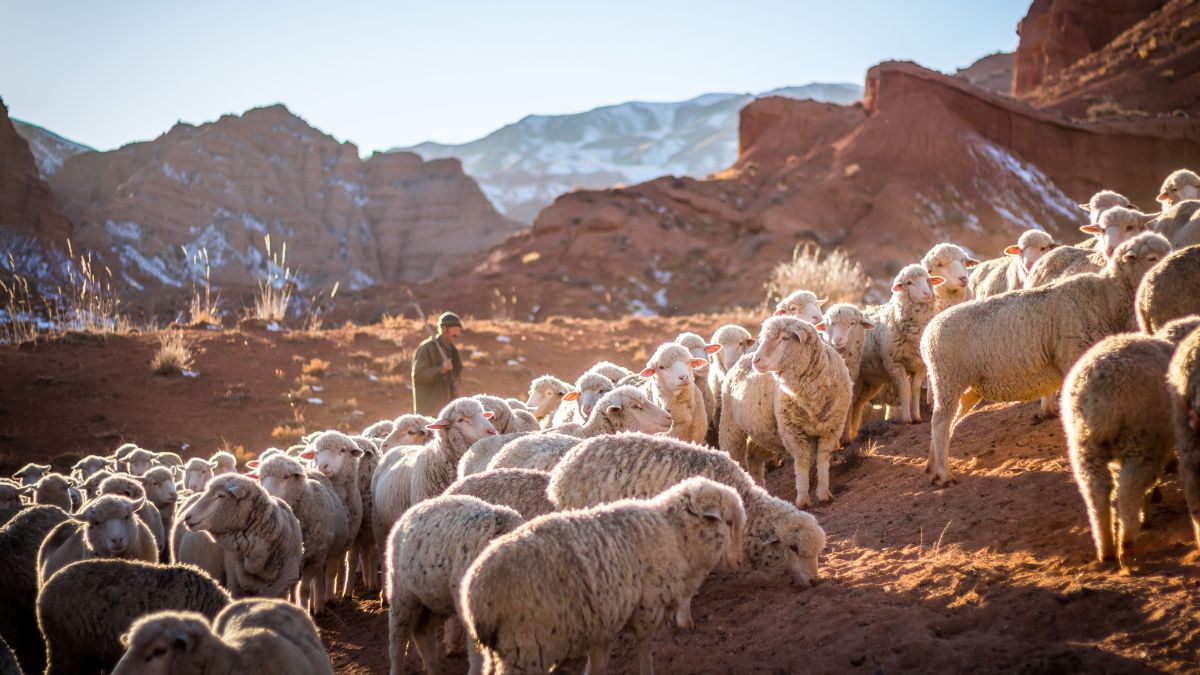Can Sheep Live Without a Shepherd? Explained

Have you ever wondered how important the role of a shepherd is to a flock of sheep? If left to their own devices, would these gentle, woolly creatures manage to navigate the complexities of survival? The enduring image of a shepherd guiding his flock is deeply ingrained in our cultural consciousness, but is this guidance truly indispensable?
In this article, we dive into an intriguing exploration of whether sheep can indeed live without a shepherd, breaking down the question from various angles – ecological, behavioral, and societal – to provide a comprehensive answer.
Understanding the Role of a Shepherd: History and Today
The shepherd, a universal symbol of guidance and care, has been an integral part of agrarian cultures worldwide. The occupation of shepherding dates back thousands of years, with evidence found in ancient civilizations across Asia, Africa, and Europe. In those times, the shepherd’s role was not just tending to sheep but also providing wool, milk, and meat, making them essential to community survival and prosperity.
In historical terms, the shepherd’s duties encompassed far more than mere herding. They were responsible for protecting the flock from predators, ensuring they had access to food and water, managing breeding, assisting with birthing, and nursing sick animals back to health. This holistic approach built a profound understanding and bond between the shepherd and his flock, nurturing the domestication process that made sheep farming widespread.
Today, the role of the shepherd is much the same, though the tools and methods have evolved. Modern shepherds may use technologies like drones and GPS collars for herding and monitoring, replacing the traditional staff and dogs to some extent.
However, the underlying principle remains the same: the shepherd is the guardian, guide, and caretaker, essential for maintaining a healthy, thriving flock. The question, then, is whether sheep, so accustomed to human intervention, could revert to their ancestral instincts and survive without this watchful custodian.
The Natural Behavior and Instincts of Sheep: An Overview
Sheep, like all animals, are equipped with a set of natural behaviors and instincts that have helped their species survive and adapt over the millennia. Understanding these instincts provides insight into how sheep might fare without human intervention.
Grazing Habits: Sheep are ruminants with a preference for grass and clover. In a natural setting, they’ll roam and graze throughout the day, often covering large areas in the process. This natural tendency helps distribute their impact on the environment and aids in their nutrient absorption.
Herd Mentality: Sheep are highly social animals and instinctively move in flocks for safety and companionship. This herd mentality is a key survival instinct, as there’s safety in numbers. When one sheep moves, the others tend to follow, and if a sheep gets isolated, it can become stressed and disoriented.
Flight Instinct: Sheep have a strong flight instinct when faced with a potential threat. They prefer to run from danger rather than face it, given their lack of natural defense mechanisms.
Lambing: Ewes have strong maternal instincts and will often seclude themselves when ready to give birth, finding a safe and quiet place to lamb.
Navigational Skills: Recent studies have shown that sheep have good memory and spatial recognition skills. They can remember the faces of their flock-mates and human handlers for years, and can navigate back to a location if they’ve been there before.
Despite these innate behaviors, domesticated sheep have been bred and raised under human care for generations, potentially diminishing their ability to survive without a shepherd’s guidance. However, these instincts offer a glimpse into the autonomous capabilities that sheep could employ when left to their own devices.
Can Sheep Survive on Their Own? An Ecological Perspective
From an ecological standpoint, the potential for sheep to survive without a shepherd is a complex issue. It requires consideration of various factors, such as the availability of food and water, exposure to predators, and the ability to adapt to environmental conditions.
Food and Water Availability: Sheep have evolved to graze on a variety of vegetation types, including grasses, clover, and even shrubs. As such, in regions where these food sources are abundant, sheep could potentially find enough food to sustain themselves. Similarly, in areas with regular rainfall or access to natural water bodies, hydration might not pose a significant issue.
Predators: One of the main threats to sheep survival in the wild is predation. Without the protection of a shepherd or trained sheepdogs, sheep are vulnerable to wolves, coyotes, large cats, and even birds of prey in certain regions. Their natural flight instinct and tendency to flock together provide some defense, but the absence of a vigilant protector would undoubtedly increase their risk.
Environmental Conditions: Sheep are incredibly resilient and can thrive in various climates, from the highlands of Scotland to the arid regions of Australia. However, they may struggle in extreme weather conditions without the shelter and care provided by a shepherd. For instance, heavy snowfall can cover grazing lands, making it difficult for sheep to find food, while in hot climates, they might suffer from heat stress.
Disease and Injury: In the absence of a shepherd, medical issues such as injuries, infections, or parasite infestations could pose serious problems. Sheep can’t treat themselves when hurt or sick, and a minor wound or illness could escalate to a life-threatening condition without human intervention.
While certain ecological conditions might favor sheep survival without a shepherd, several inherent risks and challenges make such a situation precarious. These realities underline the significant role shepherds play in ensuring the welfare and survival of their flocks.
The Impact of Human Intervention on Sheep Survival
Human intervention has played a pivotal role in the survival and success of sheep as a species. Over thousands of years, humans have selectively bred sheep for traits like docility, wool quality, and meat production, which while advantageous for human use, may have impacted their natural survival abilities. Let’s delve into how human intervention influences the lives and survival of sheep.
Breeding and Genetic Changes: Selective breeding has led to sheep varieties that are highly dependent on human care. Some breeds have been developed to grow heavy wool coats that need shearing – without this, the sheep could suffer from overheating or mobility issues. Similarly, certain meat breeds may struggle with issues related to their size and weight.
Nutritional Dependence: Domesticated sheep are often fed supplementary diets, particularly during winter or in areas with poor grazing. This dependence on humans for food could be problematic if sheep were left to fend for themselves.
Healthcare: Sheep, like all livestock, are vulnerable to a range of diseases and parasites. Farmers play a crucial role in disease prevention and treatment, through vaccination, veterinary care, and maintaining hygiene standards. Without this care, sheep are more susceptible to illnesses that could drastically affect their survival.
Protection from Predators: One of the most significant roles of a shepherd is to protect the flock from predators. Without this safeguard, many sheep populations would be at a much higher risk from predators, potentially leading to significant losses.
Impacts on Behavior: Constant human interaction has also influenced sheep behavior. Many domesticated sheep have lost the need to rely on some of their survival instincts due to the security provided by human care. Without a shepherd, these behaviors may take time to redevelop, if they can be redeveloped at all.
Human intervention has made sheep one of the most successful livestock animals globally, but it has also led to a level of dependency that could seriously challenge their ability to survive without a shepherd or similar human care.
Reevaluating Sheep Farming: Sustainable Alternatives and Possibilities
As we grapple with the realities of environmental change and the need for sustainable practices in agriculture, reevaluating traditional sheep farming methods becomes necessary. With this understanding, let’s explore some sustainable alternatives and possibilities that could allow sheep to maintain a degree of autonomy while also ensuring their welfare.
Holistic Management: This approach emphasizes the mimicry of natural processes to restore grasslands and promote biodiversity. Sheep are moved around pasturelands to prevent overgrazing and allow vegetation to regenerate, simulating the natural movements of wild herbivores. In turn, this reduces the need for supplemental feeding and promotes healthier soil and ecosystems.
Predator-friendly Farming: This method involves using non-lethal means to deter predators, such as guardian animals (like dogs, donkeys, or llamas), electric fencing, or alarm systems. While the shepherd’s role remains vital in this approach, the focus shifts from constant protection to creating a balance between livestock and local wildlife.
Low-stress Animal Handling: This philosophy believes that reducing stress in livestock improves their overall health and productivity. Techniques involve understanding and working with animal instincts, allowing them to express natural behaviors, and reducing fear-based responses.
Selective Breeding for Hardiness: Some farmers are selectively breeding their flocks for traits that promote survival and adaptation to local conditions, such as disease resistance, birthing ease, and the ability to thrive on lower-quality forage. These sheep could potentially fare better without human intervention compared to more specialized breeds.
Innovative Technology: Technologies like GPS tracking, drones, and health monitoring devices can help monitor and manage flocks with less human interaction, giving sheep more freedom while still ensuring their welfare.
While these practices show promise for a future where sheep might maintain more autonomy, it’s crucial to remember that the welfare of the animals should always be the priority. Any transition towards less hands-on management should be done cautiously, ensuring the sheep’s needs are met at all stages.
By continuing to explore and implement sustainable alternatives, we can work towards a balance between human needs, animal welfare, and environmental health.

